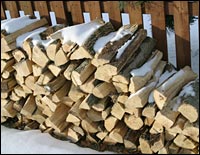Dear Umbra,
We pile on socks and sweaters, but there are just times you need more warmth. Should we use the fireplace or our central (gas-powered) heater? Also, can you let us know which is better, natural firewood or those chemically infused logs that claim lower particulate matter is released?
Kas Sut
Davis, Calif.
Dearest Kas,
Although we’ve contemplated this heating dilemma before, I find I have more to say about fire.
Don’t use the fireplace. It is probably the least efficient way to heat a room. Remember the story about amazing Ben Franklin inventing the wood stove, and how mind-blowing it was, because it actually sits out in the room and radiates heat all about? Fireplaces didn’t produce effective heat in Franklin’s time, and they don’t produce effective heat now.

Pile on the sweaters, not the wood.
Photo: iStockphoto.
Think about it: you light a fire in a recessed hole. The bricks absorb the heat, and logically they radiate the heat, but to where? Up the flue or out the exterior wall of the house. The fireplace is large enough that the heat is never concentrated and forced into the room. A fire requires air to keep burning, so it basically sucks air out of the room — air you likely used the furnace to heat — or through cracks in the walls from outside, and then heats it and sends it up the chimney.
Additionally, burning wood is quite polluting. You may recall or wish to refer to an Umbric discussion of catalytic converters on wood stoves, which cut down nasty emissions. Just as in a car, a catalytic converter’s work is only possible because of the sheer amount of stuff uncombusted in the initial burning, aka pollution.
If you absolutely wish to have a fire in the fireplace, those strange sawdust/wax logs are better than wood. Be sure there are no other ingredients before you buy a brand. There are also similarly strange “Java-Logs” made from coffee grounds, which claim 85 percent less carbon monoxide and 31 percent less particulate matter than wood.
If you can close the room, a decent space heater may be an alternative.
There is another good alternative fireplace solution, but it’ll take a bit of time and a lot of money: Gas fireplace inserts are an excellent, less-polluting way to have a fire-esque experience. I’m talking about something slightly less cheesy than the fake logs in ski lodges. They’re self-contained, provide radiant heat and warm air, and can be up to 80 or 90 percent efficient, as opposed to the 10 percent efficiency of our beloved wood fireplace. Look for a high annual fuel utilization efficiency rating, and a good BTU rating. From my experience they work quite well, for a low, low cost of — $1,000 to $3,000. Oop.
Skinflintily,
Umbra

